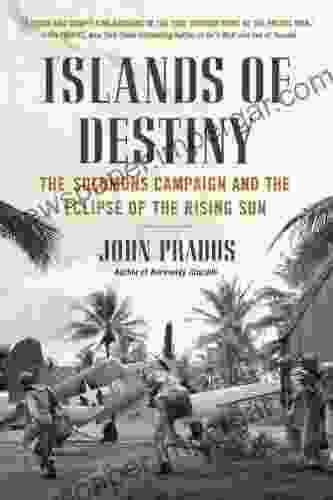The Solomons Campaign, a pivotal chapter in the annals of World War II, unfolded across the remote yet strategically vital islands of the Solomon archipelago in the Pacific Ocean. This grueling and protracted struggle, spanning from 1942 to 1945, marked a decisive turning point in the conflict, signaling the gradual eclipse of Japanese imperialism and the ascendance of the United States as a global superpower.
4.2 out of 5
| Language | : | English |
| File size | : | 3076 KB |
| Text-to-Speech | : | Enabled |
| Screen Reader | : | Supported |
| Enhanced typesetting | : | Enabled |
| X-Ray | : | Enabled |
| Word Wise | : | Enabled |
| Print length | : | 416 pages |
In this article, we embark on a comprehensive analysis of the Solomons Campaign, examining its key battles, strategies, and far-reaching consequences. By exploring the pivotal moments and strategic decisions that shaped this historic conflict, we gain insights into its profound impact on the course of World War II and the geopolitical landscape that emerged in its aftermath.
The Strategic Significance of the Solomons
The Solomon Islands, a chain of archipelagos stretching northeast of Australia, held immense strategic importance during World War II. Control over these islands would provide a critical foothold for either side, offering access to vital shipping lanes and airfields. For Japan, the Solomons represented a vital stepping stone in their southward expansionist ambitions, aiming to secure resources and establish a defensive perimeter around their newly acquired territories.
For the United States, the Solomons were equally crucial. Their capture would not only deny Japan a strategic advantage but also provide a much-needed base for launching counteroffensives against Japanese-occupied territories. Moreover, securing the Solomons would contribute to the overall Allied strategy of isolating and ultimately defeating Japan.
Key Battles of the Solomons Campaign
- The Battle of Guadalcanal (August 1942 - February 1943): A protracted and bloody battle for control of the strategically vital island of Guadalcanal, marking a major turning point in the Pacific War. The fierce fighting resulted in heavy casualties on both sides, ultimately leading to a pivotal American victory.
- The Battle of the Eastern Solomons (August 1942): A naval engagement between American and Japanese forces in the waters near the Solomon Islands, resulting in a tactical victory for the Americans and the sinking of the Japanese carrier Ryujo.
- The Battle of the Santa Cruz Islands (October 1942): A major naval battle between American and Japanese carrier forces, ending in a tactical draw but inflicting significant damage on both sides. The battle showcased the growing strength of the American navy and its ability to challenge Japanese naval dominance.
- The Battle of Rennell Island (January 1943): A naval engagement between American and Japanese cruisers and destroyers, resulting in a Japanese victory but failing to alter the overall strategic situation in the Solomons.
- The Battle of Tassafaronga (November 1942): A naval engagement between American and Japanese forces in the waters near Guadalcanal, resulting in a Japanese victory but underscoring the growing American naval strength and their ability to inflict significant damage on Japanese warships.
Strategies and Tactics
The Solomons Campaign was characterized by a complex interplay of strategies and tactics employed by both sides. Japan, initially enjoying air and naval superiority, sought to establish a defensive perimeter around its newly acquired territories and launch opportunistic attacks on American forces. However, as the war progressed, the United States gained the upper hand, leveraging its industrial might to produce more ships, aircraft, and supplies.
American forces employed a strategy of "island hopping," capturing key islands and airfields in the Solomons one by one, gradually pushing towards Japan's home islands. This strategy allowed the Americans to neutralize Japanese strongholds, establish forward bases, and bring Japan under increasing aerial bombardment.
Consequences and Legacy
The Solomons Campaign had far-reaching consequences that shaped the course of World War II and beyond. The American victories in the Solomons marked a turning point in the Pacific War, signaling the gradual decline of Japanese imperialism and the rise of the United States as a global power. Moreover, the campaign demonstrated the effectiveness of American island hopping strategy, which would be employed throughout the remainder of the war.
The Solomons Campaign also had a profound impact on the post-war Free Download. The defeat of Japan led to the dissolution of its empire, the liberation of millions of people from colonial rule, and the emergence of a new geopolitical landscape in the Asia-Pacific region. The United States emerged from the war as the world's preeminent superpower, with its influence extending across the globe.
The Solomons Campaign stands as a testament to the pivotal events that transpired during World War II. The fierce battles, strategic decisions, and far-reaching consequences of this epic conflict had a profound impact on the course of human history. By analyzing the key aspects of the campaign, we gain insights into the decline of Japanese imperialism, the rise of the United States as a global power, and the geopolitical transformations that shaped the post-war world.
The legacy of the Solomons Campaign continues to resonate today, reminding us of the complexities of war, the importance of strategic decision-making, and the resilience of the human spirit in the face of adversity. As we delve into the annals of this historical event, we not only pay tribute to the sacrifices made by those who fought but also gain valuable lessons for the future.
























































































